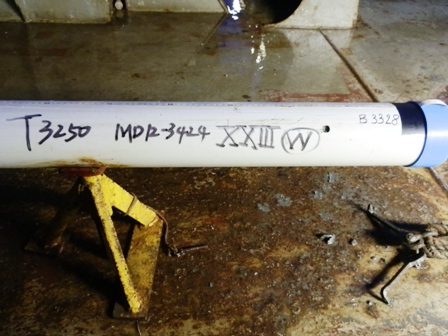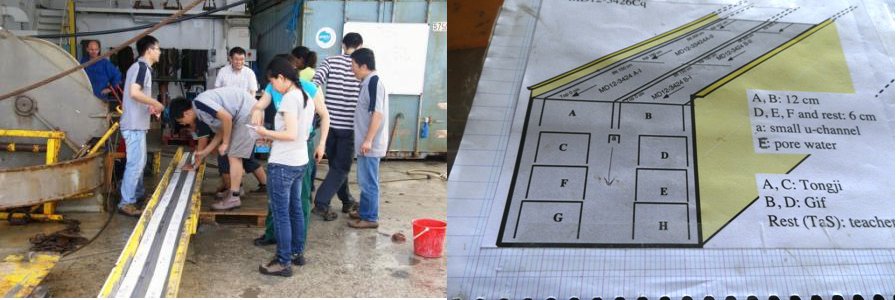Since last week, GeoLog has had the pleasure to host reports from Teachers at Sea. This educational programme, co-sponsored by the European Geosciences Union (EGU) and the French Polar Insitute (IPEV), gives school teachers the opportunity to take part in oceanographic cruises with scientists. This year, Sandrine Vivier and Ana Sánchez, teachers of Biology and Geology in Rodez (France) and Madrid (Spain), respectively, together with EGU’s Education Chair Carlo Laj, join scientists on board of the Marion Dufresne. The research vessel is navigating the South China Sea where teachers will work alongside scientists in collecting marine sediments to retrieve the secrets of deep ocean circulation and understand past variations of the Asian Monsoon.
Report 7: Handling a core on board
When a corer arrives at the surface, the crew of the Marion Dufresne lifts it on to the deck. This is not a simple operation, especially considering the length of some of the Calypso cores recovered during this cruise. It involves separating the huge weight of about six or seven tons from the corer itself, and then laying down the core along the starboard corridor (if a Calypso) or on the rear deck (if a Casq). The crew also takes the plastic liner out of the metallic tube (Calypso) or unscrews the numerous bolts that seal the Casq core.
From then on, the scientists take over. For a Calypso core, as mentioned in a previous report, our duty is first to cut it into 1.5 meters sections and label it precisely. The plastic liner impresses a straight, longitudinal ‘fiducial line’ along the core, which is used later to split the core into two halves, one to work on and one to archive. The labelling is therefore done on both halves.
A typical label may seem rather complex to those not on the ship: ‘MD12-3432-X’ with additional labels ‘T-1350’ at the top and ‘B-1500’ at the bottom, is an example. But the letters and numbers have very precise meanings that later help to identify the core. ‘MD12’ indicates that it was taken by the Marion Dufresne in 2012 and ‘3421’ that it is the 3432th core taken by this vessel (!). The Latin character X labels the tenth section of the core, which extends from 1350 cm at the top (T) to 1500 cm at the bottom (B).
For a Casq core, sampling is done differently, as there is no external plastic liner. Plastic liners, called D-tubes are pushed inside the sediment, labelled in a way identical to Calypso cores, and then extracted after cutting the sediment with a nylon string (a fishing line). The different D-tubes are then covered with a lid that fits tightly on them. Due to the large dimensions of a Casq core, we can obtain three different levels of D-tubes from it.
The team splits the Calypso core sections into two longitudinal splits along the fiducial line (so that their relative orientation is preserved) using an automated saw. The instrument used on the Marion Dufresne is affectionately called Georginette in honor of Georges Oggian, the engineer from the University of Bordeaux who designed it.
The scientific team immediately packs and stores the archive half, while the working half is submitted to some measurements (preliminary to the on shore laboratory studies). Done in the Mechanical Stability Testing or MST container, using a specific instrument, these include taking a photographic record of all the sections, measuring the magnetic susceptibility of the sediment, recording its optical reflectance (a first order measurement of its mineralogical composition), its density (via absorption of gamma rays), and the speed of sound in it via the velocity of seismic P-waves. These last two measurements are linked to the sediment density.
The team also does the sedimentological description of each section to characterise possible changes in the sediment. This would reflect changes in the paleoenvironmental conditions or, in other words, changes in the environment at a given period in the geologic past.
A first, very important, analysis is the microscopic observation of the foraminifera content in the part of the sediment present in the lowermost part of the core (the core catcher). The presence of a Globigerinoides ruber (pink) type of foraminifera at the bottom of the core indicates that this core has reached the ‘age’ of 130,000 years (more or less one climatic cycle). This analysis guides the choice of successive coring sites.
As you can see, there is a lot of work involved in handling a core on board! Just the task prior to the analysis, sampling a Calypso or a Casq core, takes more than the four hours of a shift. Therefore, different shifts each do a part of the work.
Ana and Sandrine are in the 4-8 shift, meaning that they work from 4 to 8 in the morning, and again from 4 to 8 in the afternoon. They work under the direction of the experienced Aurélie Vantoer, who has participated in many Marion Dufresne cruises.
Carlo is not assigned to a specific shift. His job is to ‘spot’ suitable coring sites using the 3.5 KHz sub-bottom profiler – a sonar projected into the seafloor to see down into the sediment. He is active almost round the clock, together with our two co-chief scientists, Catherine and Zhimin.
It is hard work on board, but we are excited to see what the next coring operations will bring!
By Sandrine Vivier, Ana Sánchez, and Carlo Laj






Louise
Hi, I came across your blog today and I’m very interested and jealous to see the work you are undertaking! I am part of the UK Royal Navy and I’m currently completing a comparative study with the RV Marion Dufresne and HMS Scott. Will you be looking at its Thomson-Marconi TSM 5265 multi-beam sonar swath-mapper? I’m interested it its sonar capabilities. Regards,
EGU Media
Hi Louise,
Thank you very much for your comment! I am glad you are interested in the work Carlo, Sandrine and Ana are doing on the Marion Dufresne. I will pass on your question to them.
Best wishes,
Bárbara
EGU Media
Hi again Louise,
Carlo Laj said: “for this kind of information I would prefer that the person contacts directly Hélène Leau, the Operation Manager of the French Polar Institute (IPEV): hleau@marion.ipev.fr or in France hleau@ipev.fr“.
Best wishes,
Bárbara